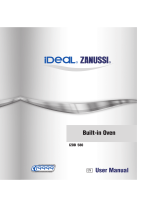
2
Important Safety Information
Installation
l Any modification of the domestic electrical
system which may be necessary prior to the
installation of the appliance should be
carried out solely and exclusively by
competent personnel.
Child Safety
l This appliance has been designed for use
by adults. Care should therefore be taken
that children do not attempt to play with it.
l The oven remains hot for a considerable
length of time after being switched off.
Children must be watched continuously,
and special care should be taken that they
neither touch the surfaces and nor play
anywhere near the appliance, either when it
is in operation or before it has cooled down
completely.
During Use
l This product was designed for cooking
food, and must not be used for other
purposes.
l Care must also be taken when using spray
cleaning products . Never direct the spray
onto the filter (in those appliances which
possess one), the resistances and the
thermostat bulb.
l Always use oven gloves when removing
dishes from the oven.
l It is dangerous to modify or attempt to
modify the characteristics of the appliance.
l Ensure that the control knobs are in the
0 position when the appliance is not in
operation.
l Always insert the dripping-pan when using
the grill or cooking meat on the grill.
l Make sure that the oven grills have been
inserted correctly.
It is of the utmost importance that this booklet be kept with the appliance, so that it can be
consulted for any reason.Should the appliance be sold or transferred to another owner,
please ensure that the booklet goes with it, so that the new user is able to become familiar
with its operation and the relevant warnings.
These warnings have been included for your safety and for that of others. We ask you,
therefore, to read them carefully before installing and using the appliance.
l Ensure that the appliance is unplugged and
completely cooled before undertaking any
maintenance or cleaning operation.
l Do not line the walls of the oven, especially
the lower part, with tinfoil.
l Pour a little water into the dripping-pan to
avoid burning fats producing unpleasant
odours.
l For reasons of hygiene and safety this
appliance must always be kept clean (see
relative instructions).
l When the oven and the grill are in use the
appliance is subject to considerable
heating of the glass of the oven door and the
adjacent parts. Care should therefore be
taken that children do not attempt to play
anywhere near it.
l If other electrical appliances are plugged
into a socket near the oven, make sure that
the cable neither touches the heated
cooking zones nor gets caught in the oven
door.
Technical Assistance
l In the case of technical problems, contact
your nearest Technical Assistance Centre
and be sure to ask for original spare parts.
l Never attempt to carry out any type of repair
yourself. Repairs done by unqualified
individuals can cause damage to the
appliance. Contact your nearest Assistance
Centre and use only original spare parts.
Environmental Information
l After installation, please dispose of the
packaging with due regard to safety and the
environment.
l When disposing of an old appliance, make it
unusable, by cutting off the cable.




















